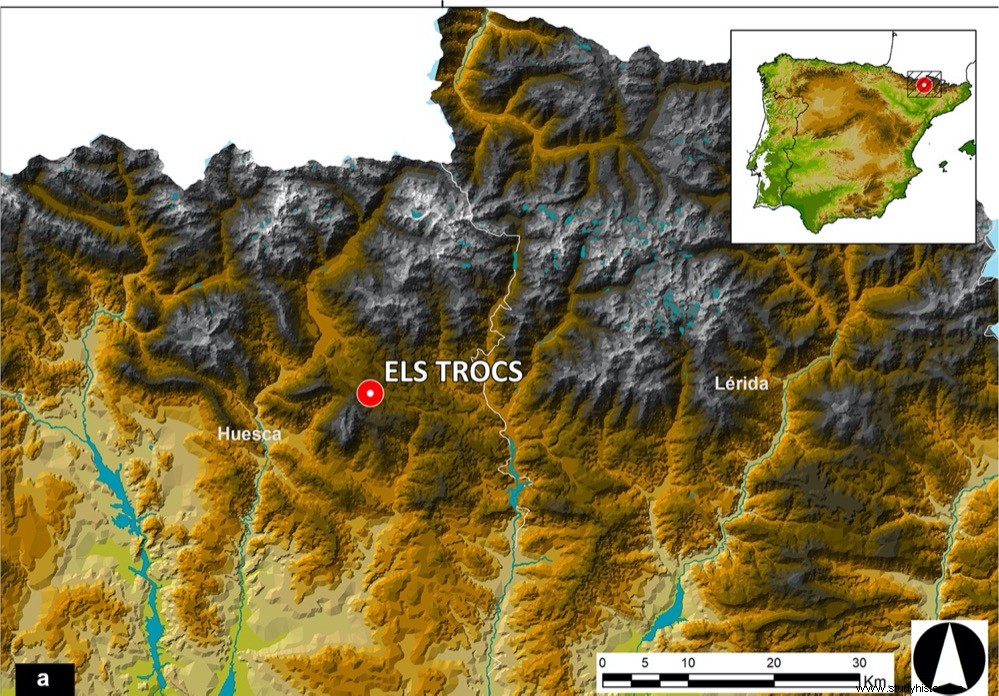At the Els Trocs cave site in the Pyrenees (San Feliu de Veri, Bisaurri, Huesca), rival groups of primitive migrant farmers or indigenous farmers and hunter-gatherers clashed violently around 5300 BC. This clash resulted in a massacre of the farmers of Els Trocs. The backlash was possibly triggered by xenophobia or mass disputes over resources or privilege, according to a study published in Nature.

The cave of Els Trocs is located in the middle of a plateau, where a mountain rises with the entrance of the cave on its slope. In addition to the material remains of its former occupants, such as ceramic and stone tools, it contains the bones of slaughtered domestic and wild animals, as well as human bone remains of children and adults. The 13 individuals identified so far can be assigned to three different phases of Neolithic occupation that are widely separated in time. Therefore, these "burials" are not a group that shared a single common destiny.
The researchers focused their analysis on nine individuals (five adults and four children) from the earliest occupation of the cave around 5326–5067 BC, whose radiocarbon dates cluster closely and all of whom show traces of peri- and post-mortem violence. Thus, the individuals of this phase I are distinguished by being separated chronologically by more than 1,000 years from those of phase II and by presenting a specific and unique set of lesions that suggest a singular episode of conflict of which these individuals were victims.
Adults show consistent injuries from arrow shots to the skull. Children and adults also show traces of similar blunt violence in the skull and throughout the skeleton. The use of projectile weapons such as bows and arrows in conflict situations is evidenced not only by bows from the nearby contemporary settlement of La Draga, but also by cave paintings from this period depicting various types of violent acts. In addition to the direct and unequivocal traces of violence, this indirect evidence supports the assumption that the individuals from Els Trocs were victims of a massacre.

The importance of the violent conflict presented here lies in the early evidence of intentional violence in the Neolithic period. Existing sources date the first events of mob violence, involving entire settlement communities, in Central Europe to the late 6th and early 5th millennium BC. The violent events in Els Trocs have no parallel in Spain or in the rest of Europe at that time. Another unusual feature is the remote geographical location of the site, far from the first Neolithic migratory routes of the Iberian Peninsula, which are on the coast or along the Ebro valley, respectively.
Population genetic analyzes characterize the victims of Els Trocs as the first Neolithic migrants, members of the communities that established agriculture and livestock in the Iberian Peninsula. They could represent the older members and children of a larger Neolithic community who, separated from the main group, spent the summer months in the Pyrenees in the course of seasonal transhumance, i.e. cattle migration.

The perpetrators of the massacre could have been indigenous hunter-gatherers who saw the Neolithic group encroaching on their foraging grounds. Alternatively, it may have been an altercation between two Neolithic groups in which disputes over land rights intensified. This reasoning considers as a reason that the terrain in which the violent event took place is a plateau that offers multiple resources.
It is possible that this was a local group that still traditionally lived as outlaws, and decided to oppose the migrants decisively and with all their might. Or it may have been another Neolithic group, either foreign or local, that disputed the victims of Els Trocs for their summer pastures.
Els Trocs probably documents an early escalation of intergroup violence between people of possibly different backgrounds and worldviews, between natives and migrants, or between economic or social rivals. The conflict conveys the impression of xenophobic action; the type of aggression suggests a clash between enemy groups.
Fonts
Alt, K.W., Tejedor Rodríguez, C., Nicklisch, N. et al. A massacre of early Neolithic farmers in the high Pyrenees at Els Trocs, Spain . Sci Rep 10, 2131 (2020). doi.org/10.1038/s41598–020–58483–9.
